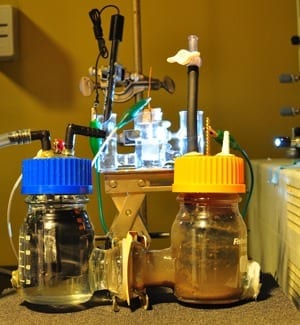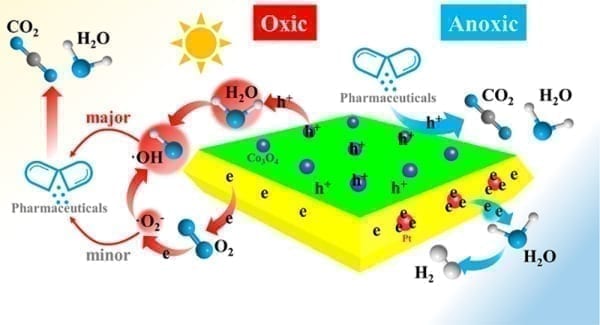A novel device that uses only sunlight and wastewater to produce hydrogen gas could provide a sustainable energy source while improving the efficiency of wastewater treatment.
A research team led by Yat Li, associate professor of chemistry at the University of California Santa Cruz, developed the solar-microbial device and reported their results in a paper published in the American Chemical Society journal ACS Nano. The hybrid device combines a microbial fuel cell (MFC) and a type of solar cell called a photoelectrochemical cell (PEC). In the MFC component, bacteria degrade organic matter in the wastewater, generating electricity in the process. The biologically generated electricity is delivered to the PEC component to assist the solar-powered splitting of water (electrolysis) that generates hydrogen and oxygen.
Either a PEC or MFC device can be used alone to produce hydrogen gas. Both, however, require a small additional voltage (an “external bias”) to overcome the thermodynamic energy barrier for proton reduction into hydrogen gas. The need to incorporate an additional electric power element adds significantly to the cost and complication of these types of energy conversion devices, especially at large scales. In comparison, Li’s hybrid solar-microbial device is self-driven and self-sustained, because the combined energy from the organic matter (harvested by the MFC) and sunlight (captured by the PEC) is sufficient to drive electrolysis of water.
In effect, the MFC component can be regarded as a self-sustained “bio-battery” that provides extra voltage and energy to the PEC for hydrogen gas generation. “The only energy sources are wastewater and sunlight,” Li said. “The successful demonstration of such a self-biased, sustainable microbial device for hydrogen generation could provide a new solution that can simultaneously address the need for wastewater treatment and the increasing demand for clean energy.”
Microbial fuel cells rely on unusual bacteria, known as electrogenic bacteria, that are able to generate electricity by transferring metabolically-generated electrons across their cell membranes to an external electrode. Li’s group collaborated with researchers at Lawrence Livermore National Laboratory (LLNL) who have been studying electrogenic bacteria and working to enhance MFC performance. Initial “proof-of-concept” tests of the solar-microbial (PEC-MFC) device used a well-studied strain of electrogenic bacteria grown in the lab on artificial growth medium. Subsequent tests used untreated municipal wastewater from the Livermore Water Reclamation Plant. The wastewater contained both rich organic nutrients and a diverse mix of microbes that feed on those nutrients, including naturally occurring strains of electrogenic bacteria.
When fed with wastewater and illuminated in a solar simulator, the PEC-MFC device showed continuous production of hydrogen gas at an average rate of 0.05 cubic meters per day, according to LLNL researcher and coauthor Fang Qian. At the same time, the turbid black wastewater became clearer. The soluble chemical oxygen demand–a measure of the amount of organic compounds in water, widely used as a water quality test–declined by 67 percent over 48 hours.
The researchers also noted that hydrogen generation declined over time as the bacteria used up the organic matter in the wastewater. Replenishment of the wastewater in each feeding cycle led to complete restoration of electric current generation and hydrogen gas production.
Qian said the researchers are optimistic about the commercial potential for their invention. Currently they are planning to scale up the small laboratory device to make a larger 40-liter prototype continuously fed with municipal wastewater. If results from the 40-liter prototype are promising, they will test the device on site at the wastewater treatment plant.
Go deeper with Bing News on:
Sun and sewage to produce hydrogen fuel
- The top 10 Green Hydrogen initiatives to watch out for
In this article, we will explore the top 10 green hydrogen initiatives that are shaping the future of energy and sustainability. The top 10 Green Hydrogen initiatives to watch out for. Exploration & ...
- Sarawak to produce green hydrogen for Japan
KUCHING: Sarawak will produce ... hydrogen, he said H2ornbill and H2biscus plants will also create new hydrogen-based industries, such as the manufacturing of electrolysers, fuel cells and the ...
- Bill Gates hooked on this hydrogen fuel and solid carbon startup
The Microsoft co-founder was so taken by the product that he personally used it to fill a pothole. Bill Gates recently visited a climate tech startup in the Se ...
- News tagged with hydrogen fuel
fuel cells convert the chemical ... Researchers have devised a novel catalyst aimed at enhancing the efficiency of reactions using contaminated municipal sewage to produce hydrogen—a green ...
- Fuel of the future is here
Carbon dioxide is not released or involved at any stage, and the clean hydrogen in fuel cells can be used to heat homes and offices and power transportation. “We in Nepal have an opportunity to use ...
Go deeper with Google Headlines on:
Sun and sewage to produce hydrogen fuel
[google_news title=”” keyword=”Sun and sewage to produce hydrogen fuel” num_posts=”5″ blurb_length=”0″ show_thumb=”left”]
Go deeper with Bing News on:
Hydrogen fuel
- Varanasi pilot location for deployment of green hydrogen fuel cell inland vessels on NW-I
New Delhi, Varanasi has been selected as the pilot location for deployment of green hydrogen fuel cell inland vessels on National Waterways-I, aligning with the government's Harit Nauka guidelines, an ...
- Alberta wants more hydrogen vehicles. Experts say fuel infrastructure needs to come with them
Experts say building Alberta's hydrogen-fuelled transportation sector means working through a big question: Which comes first, the hydrogen vehicles, or the fuelling stations?
- World’s first hydrogen station for commercial trucks opens – is it too late?
FirstElement Fuels has opened the world's first large-scale hydrogen fueling station for heavy-duty commercial trucks at Port of Oakland.
- 4,000% boost! Eco-friendly hydrogen on the horizon
The hydrogen produced can be stored and used later, for instance, to power an electric car when combined with a PEM fuel cell. However, PEM electrolysis has limitations that hinder its widespread ...
- Really Cold Hydrogen Could Bring Driving Range Parity with Diesel
The time it takes to fuel a hydrogen-powered fuel cell truck is already on par with diesel. But there is still a yawning gap when it comes to comparable driving range.
Go deeper with Google Headlines on:
Hydrogen fuel
[google_news title=”” keyword=”hydrogen fuel” num_posts=”5″ blurb_length=”0″ show_thumb=”left”]











